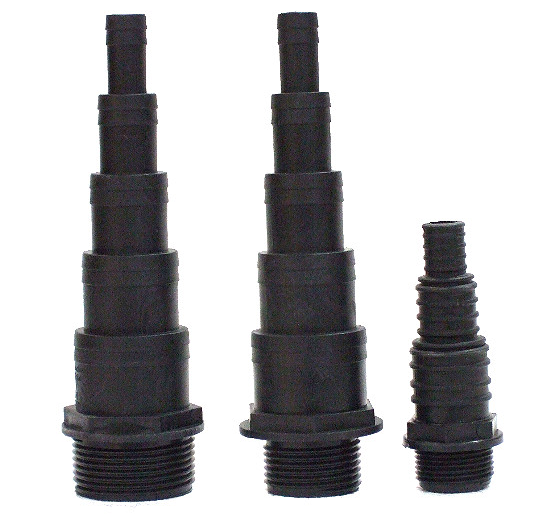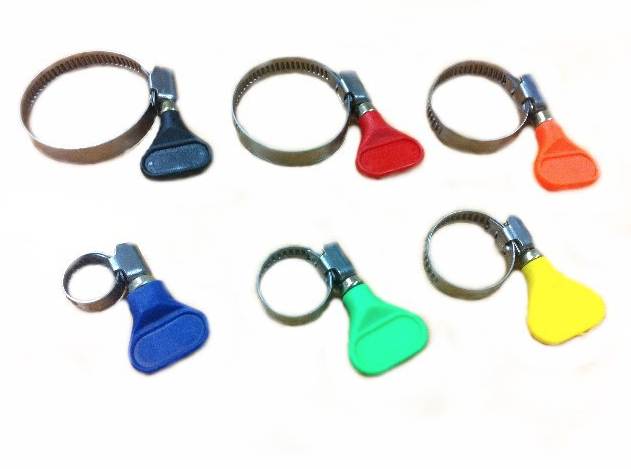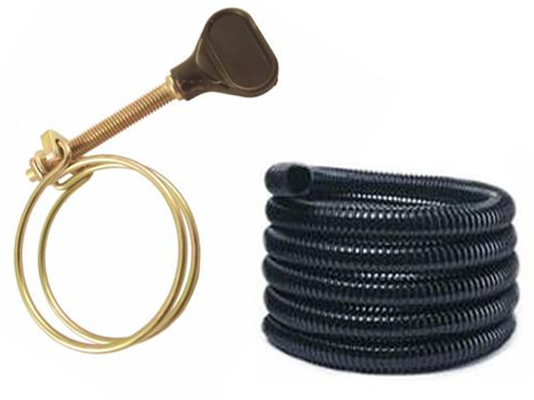Selecting the right pond hose and hose clips for your pond pump
If you want to power a waterfall or connect your pump to a filter or UVC, you’ll need some pond hose.
Pond hoses come in different types and sizes to do different jobs and handle different flow rates in the pond. The hose must be wide enough not to restrict water flow from the pump, flexible so that it doesn’t kink, and it needs to fit onto pond pumps and filters at each end without leaking.
Flexible pond hoses
Flexible pond hose is the most popular method for connecting pond pumps to filters, UVCs and waterfalls. The most popular pond hoses are black, ribbed hosing which bends easily and has ribs in the outer wall to stop it from kinking. Flexi hose is black to prevent algae from growing inside it and it can endure all weathers too. It’s our most popular type of pond hose.
Flexi hose comes in seven sizes from 12mm to 50mm internal diameter. It will also fit onto imperial sizes of hose tail like 12mm for ½”, 20mm for ¾”, 25mm for 1 inch, and so on. Measure out what you need, select the number of metres and add to the basket. Although straight connectors are available to join two lengths of hose together, add a metre or two of spare when measuring to give the hose some slack, and to make sure you have enough.
What diameter pond hose to use
When water is pumped through a hose it experiences something called frictional loss. This negatively affects the flow rate of the pond pump, so we always use as wide a hose as possible to try to negate this.
Pond pumps connect to pond hose via a hose tail fitting, which may be just one size, several sizes supplied in one box, or most commonly a stepped hose tail which can be cut to size and fits three or four different diameters of hose.
For small pumps up to 700lph, 12mm hose is fine. Use 20mm hose for pumps up to 1500lph and 25mm hose for pumps up to 4000lph, but wider is always better on all pumps if the hose tail allows. For upwards of 4000lph use 40mm hose and large pumps producing 10000lph or more should use 50mm diameter hose so that the water flow isn’t too restricted.

Cut that pond hose tail!
When using a stepped hose tail, use a hacksaw to saw off the smaller steps that you don’t use. If you used 50mm hose with a 10000lph pump but didn’t saw off the 40, 25, 20 and 12mm smaller steps on the hose tail, the flow would be massively restricted and it would be like using 12mm hose, not 50mm.
So select the widest hose the hose tail will take, slide it on, mark it, slide it off again, and then saw off the smaller steps that aren’t being used.
Don’t forget the hose clips!
As good as black, ribbed Flexi hose is, it will leak at the hose tails if not secured properly. You’ll need at least two hose clips (also known as Jubilee clips,) if connecting a pump to a filter. One at the pump end and one at the filter end.
If you intend to use an Ultra Violet Clarifier (UVC,) inline, you’ll need four hose clips. Two from pump to UVC, and two from UVC to filter. Use the same size hose clips as hose, so 25mm hose needs a 25mm hose clip and so on.

Types of pond hose clips
Hose clips can be plastic, brass or stainless steel. Metal clips are best, can be done up the tightest, and some can be tightened by hand and not need any additional tools. Wire clips are recommended for ribbed hose as they can slide over those bumps in the hose wall.
Rarely, water may still leak from a hose tail despite the right hose and hose clip being used. Make sure the hose tail is done up tightly, it has an O ring or rubber sealing ring in place, and use PTFE tape around all threads and the hose tail to provide an even more secure fit.
Pond hose connectors
A wide range of hose fittings are also available to enable you to do more elaborate jobs. If you want to split the water flow use a T piece or a Y connector, again with a hose clip on every hose tail. If you want to restrict flow use an inline valve. For tight bends use a 90 degree elbow, and if you need new hose tails they’re available too.
PVC pipe for ponds
Clear flexible hose is available and can be useful for small self-contained water features, although it will kink. For large koi ponds and some large filters rigid pipe can be used for an even wider bore, but a neat job.









